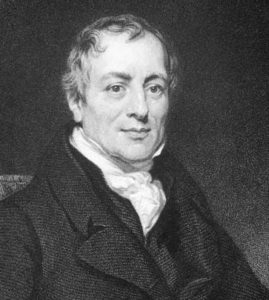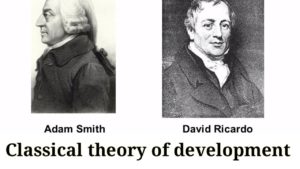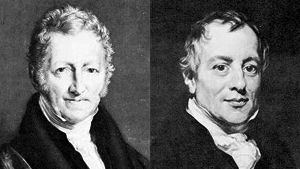
David Ricardo (1772 – 1823) was an English economist who systematized classical form to the emerging science of economics in the 19th century.
He was the third son born in a family of Shephardic Jews who had emigrated from the Netherlands to England.
Table of Contents
David Ricardo – education
Ricardo went to school in London and Amsterdam and at the age of fourteen, he joined his father in the business, who had made a fortune on the London Stock Exchange.
He grew up to be a Unitarian and broke up with his father on religious grounds. He even married Priscilla Anne Wilkinson who was Quaker. It led to a permanent estrangement from his family. His father disowned him and his mother never spoke to him again.
However, he continued to be a member of the Stock Exchange, where his talents and personality helped him to get the support of an eminent banking house. In a few years, he acquired a fortune and concentrated on pursuing his interests in literature and science, particularly in mathematics, chemistry, and geology.
He bought several seats in the parliament with the record of an earnest reformer. He held the seats until his death. In his career as a parliamentarian, Ricardo voted and fought for certain extremely important cases – he voted in support of the liberal movements in Naples and Sicily, he fought for the inquiry into the Peterloo massacre on 16 May 1821 and fought for the abolition of the death penalty for forgery.
He was determined in his support for the implementation of free trade. He was also against the imposition of sugar duties and voted against its renewal. He vehemently opposed the timber duties.
Ricardo strongly believed in parliamentary reforms and voted of them on 25 April 1822. Some of Ricardo’s notable friends included Jeremy Bentham and Thomas Malthus with whom he had a long debate over issues as the role of landowners in the society. He was also one of the members of Malthus’s Political Economy Club and the King’s Club. He was one of the founding members of The Geological Society.
David Ricardo – Political Economist
Ricardo was one of the most important figures in developing economic theory. He formulated and articulated the “Classical System” of political economy. The legacy of Ricardo dominated economic thinking throughout most of the 19th century.
Ricardo did not come to political economy until his late twenties when he read Adam Smith’s Wealth of Nation by chance. He discussed economic issues with his friends and it was on their persistent encouragement that he took up writing on political economy.
His first printed piece came in the Morning Chronicles – a letter on the high price of gold and the depreciation of banknotes. In 1797, the parliament suspended the convertibility of Bank of England notes to gold coins or bullions, leaving England effectively with a fiat paper currency parallel to its coinage.
This caused the Bullionist controversy which followed since then with pamphleteers trying to raise awareness about the divergence of the value of the paper pound and its gold equivalent. Ricardo was a supporter of the Bullionist position and blamed the rising inflation of the suspension of the convertibility of banknotes. He urged the immediate resumption of conversion of paper money into gold.
In preparing his argument, Ricardo made the outline of what came to be known as “classical approach” to the theory of money. His letter led to the formation of a Parliamentary committee under Francis Horner in 1810 to investigate the bullion question.
The committee finally agreed to Ricardo’s suggestion and recommended resumption. It was, however, strongly critiqued by several economists and therefore got defeated when put up as legislation in the following year.
David Ricardo – The Corn Laws
In 1813, another committee was formed under Henry Parnell and its report proposed a dramatic revision of the Corn laws. It set up a protectionist system that would prohibit the importation of grain altogether until domestic grain prices rose above a certain high point (80 shillings per quarter). Legislative action was postponed on this one as well.
Ricardo then returned to publish his groundbreaking work Essay on…Profit in 1815. It was with the hope to influence the debate regarding the corn laws. Parnell wanted to prove that his propositions were not merely aimed at protecting the landlords and showed the prospect of agricultural improvements.
Ricardo wanted to prove Parnell wrong and show that every one of his arguments was incorrect. Ricardo’s Essay introduced the differential theory of rent and the “law of diminishing returns” to land cultivation.
It came to be known as the “Ricardian theory of rent”, however, Robert Malthus, Edward West and Robert Torrents also had a significant contribution. They worked on it simultaneously and independently. In fact, Ricardo’s essay was directly a response to a letter of Malthus who was mildly supportive of the law.
David Ricardo’s Principles of Political Economy and Taxation
Ricardo was urged to pen down his ideas and principles of the economy by James Mill, who served as an editorial mentor, teacher, and the greatest supporter to Ricardo. The treaties of Principles of Political Economy and Taxation came out in April 1817. It received a strong review by John Ramsay McCulloch and sold extremely well.
David Ricardo – Labour theory of Value
Ricardo felt that in a multiple – commodity economy, for rents and profits to remain residual, prices needed to be pinned down somewhere. In his book, Ricardo formulated a theory of value into his theory of distribution. For him, the correct theory was the “labour embodied” theory of value or LTV, i.e. the argument that the relative natural prices of commodities are determined by the relative hours of labour expended in their production.
David Ricardo and Adam Smith Comparison

Ricardo started his book by criticizing Adam Smith’s alternative theory – the “labour commanded” and “adding up” theories of value – arguing that that made value a function of wages and thus income distribution. Ricardo found it untenable. In his opinion, value was independent of distribution and therefore, only the “labour – embodied” theory made sense.
Ricardo soon realised that when the question of the capital comes in, there came a problem: as every industry applied different amounts of capital per labour, hence, the rate of profit also differed across industries. He thought that if he assumed the rate of profit across different industries were equalized, then mathematically, relative prices would now vary with wages.
He, therefore, concluded that the labour theory of value would only work if the degree of capital intensity was equal among all sectors. This made him doubt his own theory.
Ricardo proposed two solutions to this argument
- He made an empirical argument that firms apply capital in a roughly proportional manner to the amount of labour invested. In this case, when profits are equalized, the resulting prices would not differ much from the value implied by the LTV. It is what Stigler called “Ricardo’s 93% labour theory of value”.
- One had to find a commodity which has the average capital per worker, so that its price would reflect labour – embodied value and thus, not change with changes in distribution. Ricardo called this “invariable standard of value”. Ricardo argued that if one could find what this standard commodity is, then the rest of the analysis would be simple.
However, despite heavy research, Ricardo could not find this standard commodity. Later, Karl Marx proposed a way out of it but the perfect solution was only found by Piero Saffra in 1960.
David Ricardo – Iron law of Wages
Ricardo’s famous law of wages came from developing Adam Smith’s definitions of the basics of capitalism. Ricardo believed that the population of the future would increase at a rate that it will soon outrun the rate of production. He, therefore, built an economic model based on achieving abstract equilibrium, to avoid such a situation.
Ricardo based his theory on the assumption of an ideal society that can be achieved by the economic rationality of people. He put forth the idea of “economic wage rate”. Ricardo argued that wages are determined by scarcity and the cost of subsisting.
As the demand for labour increases, the supply of labour sets up a system whereby workers receive a natural wage that is set by the cost of subsisting. The workers cannot really work if they are not provided with enough material well-being to survive. This is Ricardo’s Iron Law of Wages. Thus, Ricardo believed that in the long run, the workers could never earn more than a subsistence wage, but they could not earn less than that either.
In fact, he also believed that neither the government nor the labour union could do much about it because natural economic laws would interfere.
David Ricardo – Theory of Distribution
Ricardo’s theory of distribution was based on marginal and surplus principles. The marginal principle explained the share of rent in national output and the surplus principle explains the division of the remaining share in wages and profit.
Ricardo’s theory was based on the following assumptions:
- Supply of land is fixed
- The land is used for production of corn and the working force in agriculture helps in determining the distribution in the industry.
- Law of diminishing returns operates on land.
- Demand for corn is perfectly inelastic.
- Labour and capital are variable inputs.
- Capital consists of circulating capital.
- There is capital homogeneity.
- All workers are paid subsistence wages.
- The state of technological knowledge is given.
- There is perfect competition.
- Demand for labour depends upon the accumulation of capital.
- Demand and supply price are independent of the marginal productivity of labour.
- The supply price of labour is given and constant.
- Capital accumulation results from profit.
Ricardo considered agriculture as the most important sector of the economy. The difficulty of providing food to the increasing population was considered the main problem. Ricardo believed that there are three major groups in an economy – the landlords, the capitalists and the labourers among whom the entire productive land is distributed.
It is the capitalists who initiate the process of economic development in the society by reinvesting profits, and thus, increasing capital formation. The total national out is distributed among the three groups as rents, profits and wages, and the share of each group can be determined as:
- Rent per unit of labour is the difference between an average and marginal product or total rent equals the difference between the average product and marginal product multiplied by the quantity of labour and capital on land.
- The wage rate is determined by the wage fund divided by the number of workers employed at subsistence wage. Thus, of the output of total corn produced and sold, rent has the first right and then the residual is distributed between wages and profits. The interest is included in profits.
David Ricardo – Comparative advantage theory
The Comparative advantage theory attributed the cause and benefit of international trade to the differences of relative opportunity costs (costs in terms of other goods given up) of producing the same commodities among countries.
According to Ricardo’s theory which was based on the labour theory of value, the fact that only one country could produce everything more efficiently than another was not an argument against international trade.
The theory of comparative advantage makes a strong argument in favour of free trade and specialization among countries. However, the issue becomes much more complex when the theory’s simplifying assumptions – a single factor of production, a given stock of resources, full employment, and balanced exchange of goods – are replaced by more reasonable parameters.
David Ricardo and Thomas Malthus Differences

Ricardo and Malthus were both leading theorists of political economy who, throughout their careers disagreed completely on every subject of their research while remaining best friends.
Malthus was the professor of Political Economy at the East India College, Hairbury. He became famous for his books Essay on the Principle of Population which was published in 1798. He had two more books –
Malthus and Ricardo met somewhere around 1813 in a dispute over the Corn law. Ricardo was opposed; Malthus was in favour. But in arguing it out, they jointly developed the theory of rent; the theory of how national income is distributed among workers, merchants and landed gentry; and thus a basis of growth theory.
They wrote several letters to each other and published pamphlets. Their discussions led them to a deeper understanding of economics than anyone had achieved before. But they could not agree on the substantive matter of policy.
When the English economy suffered a post-war depression after the battle of Waterloo, which led Malthus to take the Keynesian position of explaining that of saving was too high and demand too low, the economy could suffer unemployment. Ricardo argued that overproduction could only be a temporary state of affairs.
Another point of dispute was over the ultimate source of value where Malthus argued for a labour-based theory of value and Ricardo argued for a cost-of-production based theory. Many more letters followed along with minute criticism of each other’s pamphlets and books.
Yet, Malthus and Ricardo were best friends.
David Ricardo’s books
Ricardo’s publications were:
- The High Price of Bullion, a Proof of the Depreciation of Bank Notes (1810).
- Essay on the Influence of a Low Price of Corn on the Profits of stock (1815).
- On the Principles of Political Economy and Taxation (1817).
David Ricardo quotes
- Nothing contributes so much to the prosperity and happiness of a country as high profits.
- The farmer and the manufacturer can no more live without profit than the labourer without wage.
- There is no way of keeping profits up but by keeping wages down.
- Profits are not made by differential cleverness, but by differential stupidity.